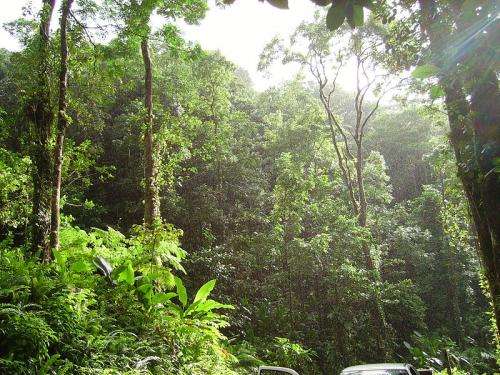April 12, 2016 report
Long-term study shows even protected tropical reserves are threatened by human encroachment

(Phys.org)—A small team of researchers from Mexico and the U.S. has found that protecting the remaining parts of the rain forest will require more than simply outlawing intrusion by mining or tree-cutting on islands of land. In their paper published in Proceedings of the National Academy of Sciences, the group outlines the problems isolated patches of protected rain forests encounter and why those problem needs to be fixed or we risk losing what we are trying to protect.
In looking at data representing forty years of study of Los Tuxtlas, a 700 acre reserve near the Gulf Coast in Mexico, the researchers have found that merely stopping logging is not enough to protect parts of the rain forest. They found that creating islands of protected forest land leads to two problems that together could spell doom for the land that is supposed to be preserved.
When all of the land around a reserve is cut down, the team explains, edge effects occur that cause gaps to appear around the periphery—those gaps allow in more sunlight in the understory, which helps young palm trees to take hold and eventually take over. Concurrently, cutting down all of the adjacent forest leads to a reduction in the number of animals that are able to live on the reserve. That reduction in animals, which mostly feed on vegetation, allows young palms to grow unfettered, which in turn leads to them encroaching ever further into the protected forest. Eventually, the researchers report, biodiversity in the protected forest will decrease to the point that it will consist mostly of palms and other small vegetation that can exist alongside of it, as most other vegetation will be pushed out, leaving a nearly otherwise barren environment.
In Los Tuxtlas, the researchers note, the problem has been exacerbated by hunters that are allowed to kill animals in the reserve, further lowering the numbers of plant eaters, making it all that much easier for the weed-like palms to take over. The encroachment going on in Los Tuxtlas is not an isolated incident either, the researchers note, anthropogenic disturbances on protected areas around the globe are threatening tropical conservation efforts, eroding the planet's overall biodiversity.
More information: Miguel Martínez-Ramos et al. Anthropogenic disturbances jeopardize biodiversity conservation within tropical rainforest reserves, Proceedings of the National Academy of Sciences (). DOI: 10.1073/pnas.1602893113
Abstract
Anthropogenic disturbances affecting tropical forest reserves have been documented, but their ecological long-term cumulative effects are poorly understood. Habitat fragmentation and defaunation are two major anthropogenic threats to the integrity of tropical reserves. Based on a long-term (four decades) study, we document how these disturbances synergistically disrupt ecological processes and imperil biodiversity conservation and ecosystem functioning at Los Tuxtlas, the northernmost tropical rainforest reserve in the Americas. Deforestation around this reserve has reduced the reserve to a medium-sized fragment (640 ha), leading to an increased frequency of canopy-gap formation. In addition, hunting and habitat loss have caused the decline or local extinction of medium and large herbivores. Combining empirical, experimental, and modeling approaches, we support the hypothesis that such disturbances produced a demographic explosion of the long-lived (≈120 y old, maximum height of 7 m) understory palm Astrocaryum mexicanum, whose population has increased from 1,243–4,058 adult individuals per hectare in only 39 y (annual growth rate of ca. 3%). Faster gap formation increased understory light availability, enhancing seed production and the growth of immature palms, whereas release from mammalian herbivory and trampling increased survival of seedlings and juveniles. In turn, the palm's demographic explosion was followed by a reduction of tree species diversity, changing forest composition, altering the relative contribution of trees to forest biomass, and disrupting litterfall dynamics. We highlight how indirect anthropogenic disturbances (e.g., palm proliferation) on otherwise protected areas threaten tropical conservation, a phenomenon that is currently eroding the planet's richest repositories of biodiversity.
Journal information: Proceedings of the National Academy of Sciences
© 2016 Phys.org

















